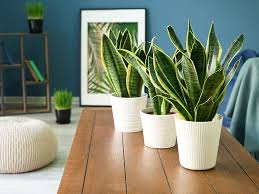Introduction
The Mother-in-Law Plant, also known as the Snake Plant or Sansevieria trifasciata, has become a favorite among plant lovers for its striking appearance and exceptional resilience. This low-maintenance plant, native to West Africa, is cherished for its upright, sword-like leaves and its ability to thrive in a variety of environments. Whether you’re a seasoned gardener or a beginner seeking an easy-to-care-for houseplant, the Mother-in-Law Plant is a perfect choice. In this article, we explore the unique features, benefits, care tips for the Mother-in-Law Plant, and common concerns related to this popular plant.
Distinctive Appearance and Varieties
The Mother-in-Law Plant is instantly recognizable by its tall, rigid leaves that grow vertically from the base. These leaves are typically green with grayish or yellow variegation, making them visually appealing in any space. There are several popular varieties, including the classic Sansevieria trifasciata, the shorter and more compact Sansevieria hahnii, and the elegant Sansevieria cylindrica, known for its rounded, tubular leaves. This diversity allows plant enthusiasts to choose the type that best suits their home or office environment. Each variety brings its own unique charm, whether it’s the dramatic vertical lines of the trifasciata or the rosette pattern of the hahnii. Because of their sculptural appearance, these plants are often used as design elements in modern and minimalist interiors. Their structural leaves contrast beautifully with softer design elements, making them a favorite in both contemporary and traditional spaces.
Benefits of Having a Mother-in-Law Plant
One of the most notable benefits of having a Mother-in-Law Plant is its air-purifying ability. NASA’s Clean Air Study identified it as one of the top plants for removing toxins such as formaldehyde, benzene, and xylene from indoor air. In today’s world, where air quality is becoming a growing concern due to urbanization and increased indoor living, having a natural air purifier like the Snake Plant can contribute significantly to a healthier home environment. Additionally, it is known for releasing oxygen at night, unlike many other plants that release oxygen during the day. This makes it a great addition to bedrooms for improved air quality while sleeping. Improved air quality can contribute to better sleep, fewer allergic reactions, and overall enhanced well-being. Beyond its health benefits, the plant also serves as a natural decorative element, adding a touch of greenery and modern style to any room. Its vertical growth pattern allows it to fit into narrow spaces, such as corners or shelves, where broader plants may not be practical.
Easy Care and Maintenance
What sets the Mother-in-Law Plant apart is its remarkable hardiness. It can tolerate low light conditions, infrequent watering, and even neglect. This makes it an ideal choice for busy individuals or those new to plant care. It is also a top pick for offices, where regular plant maintenance may not always be feasible. For best results, place the plant in indirect sunlight and allow the soil to dry completely between watering. The plant is quite forgiving but thrives when basic care guidelines are followed. Overwatering is one of the few issues that can harm the plant, potentially leading to root rot. Always ensure that the pot has proper drainage, and never let the plant sit in water. The plant also thrives in various temperatures, although it should be kept away from drafts and freezing conditions. Ideally, it should be kept in temperatures ranging from 60°F to 85°F (15°C to 29°C). Avoid sudden temperature changes, which can stress the plant. Fertilizing is not frequently required, but a balanced houseplant fertilizer applied once during the growing season (spring or summer) can support optimal growth. Repotting is rarely necessary, as these plants enjoy being slightly root-bound. However, if you notice roots growing out of the pot or the plant becoming top-heavy, it might be time to move it to a slightly larger container.
Common Issues and Solutions
While generally pest-resistant, the Mother-in-Law Plant can occasionally attract spider mites or mealybugs. These tiny pests are often found in the crevices of the leaves and can be identified by small webs or white, cotton-like patches. These can be treated with insecticidal soap or by wiping the leaves with a damp cloth. Another natural solution is to spray the plant with a mixture of water and neem oil, which helps to repel a wide range of pests. Regularly inspecting the leaves can help catch infestations early before they become a major problem. Yellowing leaves often indicate overwatering, while curling leaves may be a sign of low humidity or cold exposure. If you notice these symptoms, evaluate your plant’s environment and make necessary adjustments. Trimming off damaged or dead leaves not only improves appearance but also encourages healthy new growth. It’s also good practice to occasionally clean the leaves to remove dust, which can block light absorption and reduce the plant’s ability to photosynthesize efficiently. By monitoring your plant’s condition and adjusting its care routine accordingly, you can maintain its health and beauty for many years.
Conclusion
The Mother-in-Law Plant is more than just a stylish houseplant—it’s a resilient, air-purifying companion that requires minimal effort to thrive. Its elegant structure, variety of species, and numerous health benefits make it a valuable addition to any indoor space. Its tolerance for a wide range of lighting and temperature conditions makes it particularly versatile, and its low-maintenance nature is ideal for people with busy lifestyles or limited gardening experience. Whether placed in a living room, bedroom, bathroom, or office, this plant can elevate the ambiance and contribute to a more serene, healthy environment. With just a bit of care and attention, this plant can flourish and bring life to your home or workspace year-round.




